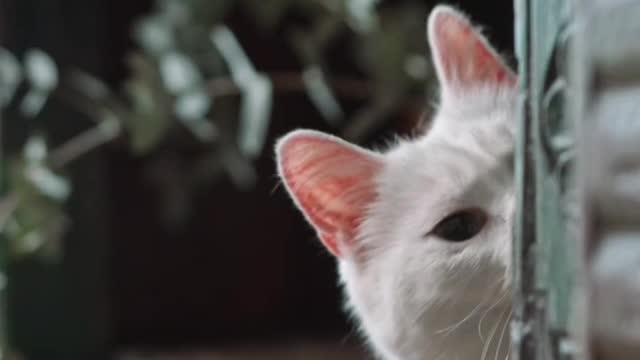Premium Only Content

Cats are really cute pet in the world.
Ask any cat person, and they’ll tell you why their cat is the cutest. For instance, my cat Margot has the softest, fluffiest fur, and the prettiest, roundest green eyes, and she makes the most adorable little mewing noises for attention. She’s just sooo cute! But it turns out, there’s a reason those particular features make me ga-ga for her.
The science of cute (yes, it’s a thing) explains why cats are so cute, and why we want these meowing purring, scratching, pooping creatures to live in our homes.
Advertisement
Defining Cuteness
Before we get into the specifics of cat cuteness, let’s talk about what “cute” means in general. If you look it up on Wikipedia, there’s actually a recognized set of characteristics that determine “cute,” all fitting under the German word kinderschema (source). They are:
Big, forward-facing eyes
Rounded ears
Floppy limbs and unstable movements
Soft, rounded body shape
A large head compared to the rest of their body
Human babies are the original source of these characteristics. Scientists theorize that appearing soft, vulnerable, and loveable is an evolutionary adaptation that ensures survival. In other words, babies are cute so that adults will take care of them!
But it’s not just human babies who trigger our caretaking instincts; kittens, puppies, lambs, and other baby animals make us feel the same way. And so do adult mammals who retain their “kinderschema.”There’s a scientific term for that, too: neoteny, or “the retention of juvenile features in the adult animal.”
Of course, not all adult cats have big heads or round eyes. But most of them have soft, rounded body shapes. They have fur that’s pleasing to touch. They make high-pitched, baby-like meows and comforting, rumbly purrs. Cats are chock full of cute characteristics that make humans want to take care of them.
How your cat’s cuteness affects your brain
As explained in this video from National Geographic, when the human brain recognizes the features of “cuteness” (whether in another human or in a cat) two things happen:
The orbitofrontal cortex (the part of the brain responsible for decision making) springs into action, telling you to protect the cute creature
The nucleus accumbens (the part of the brain also called the “pleasure center”) is activated and releases the feel-good hormone dopamine
In other words, when you see your cat do something extra-cute, your brain simultaneously tells you to protect it and rewards you for doing so. That may explain why I still love my cute cat Margot even when she pees on my dirty laundry. It also explains why kittens, in particular, set off our “squee” response.
Just picture a wide-eyed, round-bellied, soft, stumbling kitten. That adorable, helpless little thing! Don’t you just want to cuddle it and keep it safe?
Yes, yes you do.
Another term for all this: “cute cues.” As explained by the New York Times, “cute cues are those that indicate extreme youth, vulnerability, harmlessness, and need.” And people have a pretty low bar for cuteness, so anything that strikes us as even a little bit baby-like can elicit an “awww” response.
How cats got so cute
Some people think cats may have evolved to be cuter as they became domesticated in order to make people want to take care of them more. It makes sense, doesn’t it, that cats would become increasingly cute as they became increasingly dependent on human beings to survive?
However, if you’ve lived with a cat, you know that sometimes their features can be downright brooding! So why are cats so cute, even if they aren’t wide-eyed and round-featured?
One possible answer: conditioning. Humans have been living alongside cats for hundreds of years. At this point, we’re used to thinking of them as cute, even the ones who are less baby-faced. In fact, according to British anthrozoologist John Bradshaw, author of the book Cat Sense, cats’ “rather unexpressive faces” may make humans want to protect them even more.
Sound counterintuitive? Bradshaw says it’s all about projection: we humans come up with our own ideas about what a cat is thinking or feeling (source). And for many people, living in a society that values pets and makes cute cat videos go viral all the time, we often project vulnerability.
In other words, cats are cute because humans decided they were cute.
Cuteness is subjective
Beyond the classic “characteristics of cute,” we humans and our brains can see cuteness in all sorts of features. It may simply be that we naturally assume smaller creatures need more care. Or maybe we’re just conditioned to think of cats as cute.
Personal taste comes into play, too. After all, some people have different cuteness cues than others; it explains why some of us prefer smush-faced cat breeds and others go for sleek, pointy-eared cats.
I’m conjecturing here, but given our brain’s response to “kinderschema” and our innate need to nurture, it seems possible that cuteness isn’t just a list of attributes. Cuteness is a matter of taste. And at the end of the day, you probably don’t need an explanation for why your cat is so cute.
They’re cute because they’re yours, and because they’re cats, and because cats are just plain cute, darn it!
Need Cat Sitting?
Cats seem more independent than dogs, sure, but they need attention, play, and treats when you’re gone, too. Your great cat deserves great cat care. You’ve found the best cat name, so now it’s time to find them the perfect cat sitter.
-
 16:40
16:40
Actual Justice Warrior
3 days agoThe Riots Just Got More PEACEFUL
1.59K3 -
 LIVE
LIVE
Lofi Girl
2 years agolofi hip hop radio 📚 - beats to relax/study to
5,658 watching -
 2:33:27
2:33:27
Side Scrollers Podcast
17 hours agoGearbox CAVES to Gamers, Square Enix is Gay, Immigration Protests in ROBLOX | Side Scrollers Live
13.2K3 -
 3:21:58
3:21:58
The Pascal Show
11 hours ago $1.32 earnedDIDDY TRIAL LIVE! Assistant Brendan Paul 'DR*G MULE' Testifies! Diddy Trial Day 25
5.44K1 -
 17:56
17:56
GritsGG
1 day agoThis Oldschool AR is GOOD!
8.35K1 -
 2:35:16
2:35:16
TruthStream with Joe and Scott
14 hours agoJordan Clark live 4pm pacific 7pm eastern 6/17 FBI,DNC,Saving Israel for last, solar weather, technology
19K5 -
 3:25:05
3:25:05
Geeks + Gamers
11 hours agoTuesday Night's Main Event
18.9K -
 2:01:46
2:01:46
Inverted World Live
7 hours agoUFO Invasion in Columbia | Ep.60
234K6 -
 2:43:00
2:43:00
TimcastIRL
9 hours agoTrump Demands IRAN SURRENDER NOW, Mobilizes For WAR, Jets Deployed | Timcast IRL
291K182 -
 13:54:31
13:54:31
Spartan
16 hours agoPro Halo Player | Ranked Arena breaking in a new controller
104K2